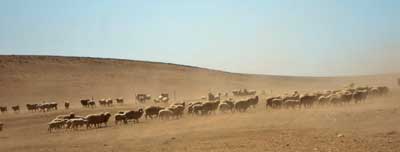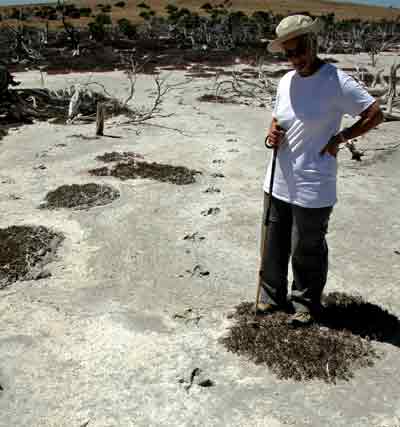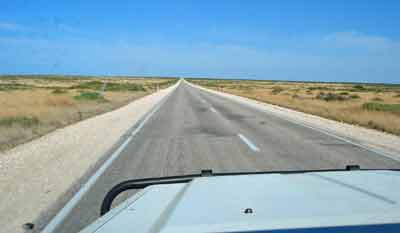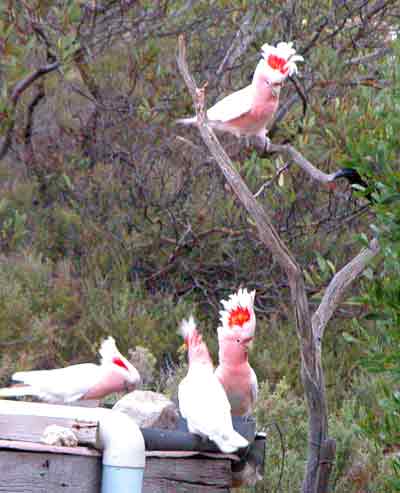Melbourne to Fremantle

NORDLYS
David and Annette Ridout
Thu 19 Oct 2006 08:45
|
Melbourne to
almost Perth
kalgoorlie
18th October 2006
Our trip to the west of Melbourne to the green
pastures of Gippsland was a revelation. This was the first, and only,
sight we had of rich green pastures in Australia. Three days of relaxing
with Tony and Linda were easily and happily spent. On one of them Annette
and I drove to Wilson's Promontory. As its name suggests this is a huge
mass of land that sticks out into the Bass Straight. The whole area being
a National Park. We managed to easily put some fifteen kilometres of
its tracks under our boots. Or at least most of it was easy, some of the
up hill bits being a little warm.
Back in Melbourne it was time to head west.
We drove up through farmland that became progressively drier. Mainly
camping but with some stops in mixture of cabins/motels we came back to Port
Augusta, our first brush with civilisation some three weeks before as we
drove south out of 'the big red centre'. Along the way we had camped by
the side of the Murray River, met a fifth generation farming family and visited
their shearing shed. We tasted their wine and had a most interesting few
hours talk during which we got a much better picture of rural life than any
books would have provided. A society where helping each other is very much
to the forefront but where the changing climate is beginning to really worry
them. Hard times in the past are acknowledged but if things do not change
in the next year then the future could be uncertain.
 The life of a sheep in Australia, 2006. This photo was
taken only
about 100km east of Adelaide
This brings me on to the whole subject of
water. Australia is the driest inhabited continent. It is in many
ways a polarised society. Rural and city dwellers with the latter by far
the largest numerically. In a democracy numbers have huge
clout. To an outsider both sides would have appeared to have
mismanaged the use of water. Some farmers grow such water hungry
crops as cotton and rice and others have hugely expanded their use of irrigation
for vines and fruit over the last decade. Billions of dollars of
investment relies on water. At the same time the ever growing cities take
from the rivers and the water table. Water conservation as we know it is
non existent. Houses are inefficient with large shower heads, few if any
temperature controls to cut down adjustment times and lots of garden
watering. The politicians have not helped by little investment and a large
amount of creaming off of profits made from the sale of water over many
years. While we have been here the clamour to put this right has been
rising. It is here however that the trouble starts because the State
Governments blame the Federal Government and vice versa. Watching this
country, as admittedly an outsider, it is hard to understand why a total of
twenty million people need to have, or can afford to have, both a full
federal government and beaurocracy and also five state versions of the
same. Enough of politics, let us continue our journey.
Not stopping in Port Augusta we headed down the
Eyre Peninsular. Here however we were met with very barren and
uninteresting countryside so we decided to cut our losses and go across to the
peninsula's western side mid way down. This proved to be a good move as we
drove through interesting and attractive farm land. Moving up the coast of
the Great Australian Bight we walked on magnificent beaches, ate excellent South
Australian oysters and saw three Southern Right Wales at the observatory
situated right at the head of the Bight. These creatures come and give
birth and mate in the coastal waters of South Australia and then, about now in
October, head off south to their feeding grounds in the Antarctic. We
were lucky enough to spot a mother and calf and another adult still in
situ. So on to the 'famous' Nullarbor plain. Actually there are
trees (Nullarbor comes from the Latin for 'no
trees') although there was also miles
and miles of nothing but low scrub and salt bushes. The latter being a
variety of grey brown small bush that gave the landscape the colour of a naval
warship interspersed with sandy red soil. We managed to do the longest
straight bit of road in Australia. Ninety miles or the distance from
Lymington to London without any bend at all. The drive was actually not as
boring as we had expecte as the landscape changed more than we
imagined. For much of the time one is driving very near the edge of ninety
metre high cliffs then one descends below this escarpment as a prehistoric
change in sea level provides a coastal plain.
 Recent Emu tracks found as we walked across the dried area
round
a salt lake in an uninhabited bit of country some 5km
inland
 Sand not snow!
This picture was taken facing west, 180 degrees round from the
one above this.
5km over these dunes lies the Great Australian Bight
 A genuine 'nullarbor' bit!
Our only serious deviation was a thirty-five km
trip to the Eyre Bird Observatory. Twenty km of this was over a very rough
dirt road then one descends down the escarpment with signs saying: 4WD low ratio
to be used. Tyres to be let down to under 20 psi. The latter
instruction proved to be necessary. As our vehicle is fitted with very wide
tyres I did not think I would need to go to the bother of tyre
deflation. I was soon proved wrong and with the engine very hot and the
wheels some six to eight inches into soft sand I let the tyres down and
proceeded easily on our way down a very narrow sand filled track. On
arrival we were met by millions of flies and were told that the only beds
available were 'outsiders'. Camping was not allowed. Outsiders were rooms
on the edge of the stone house which had a lean-to roof and some walls, no
doors. Annette was rather frightened of snakes finding her warmth
attractive! Just one km beyond the house was a really stunning beach
which we walked to and along. The evening dinner provided the usual bunch
of 'characters' which seem to congregate at such places. Oh yes there were
birds as well. The Major Mitchell Cockatoos being the most
spectacular. As evening fell the wind, lightening and rain
arrived. The latter produced something close to ecstasy in the warden and
his wife. I think that the water supply must have been lower than they
pretended. The lightning display was amazing.
 Major Mitchell Cockatoos taking hteir eveing drink, just as we
were taking ours
on the veranda of the Eyre Bird Observatory
Next morning, having slept remarkably well in our
'outsider' despite the near gale conditions, we went for a walk through the by
now fly free bush. Gone was the warm north, fly ridden wind and in was the
pleasantly cool, fly free, south westerly. We set off from here back to
the Eyre Highway and found the rain had made the sandy track much
easier to negotiate, the car's temperature hardly rising above normal at
all. Tyres blown up by our compressor and we were off. 720 km later
we were in the gold town of Kalgoorlie, checking into a good motel near the
centre of town we watched English news on Sky and downed a good whisky.
Our land adventures are almost behind us and Perth is only 600km
away. The tourist effort is still going however and this morning we have
been 120ft down a gold mine and visited one of the most impressive museums of
our travels, The Mining Hall of Fame. We pondered over an advertised
Brothel Tour this afternoon but as it called itself 'a real working
brothel' we chickened out and relaxed round the hotel pool instead.
I will get this off now with a few pictures and
finish when we get to Perth with more as I will be able to send without
using the satellite phone there.
Happy times
David and Annette
|